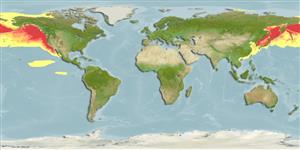Common names from other countries
Environment: milieu / climate zone / depth range / distribution range
Ecologie
Bathydemersaal. Subtropical; 90°N - 0°S, 180°W - 180°E
Pacific Ocean and the Arctic.
Length at first maturity / Size / Gewicht / Leeftijd
Maturity: Lm ? range ? - ? cm Max length : 210 cm TL mannelijk/geslacht niet bekend; (Ref. 1394); 150 cm TL (female); Maximaal gepubliceerd gewicht: 270.0 kg (Ref. 1394); Maximaal gepubliceerd gewicht: 270.0 kg
Feeds on many varieties of epipelagic and vertically migrating schooling and non-schooling fish and squid; feeding is at night (Ref. 1394). Feeds on many varieties of epipelagic and vertically migrating schooling and non-schooling fish and squid; feeding is at night (Ref. 1394).
Life cycle and mating behavior
Geslachtsrijpheid | Voortplanting | Kuitschieten | Eieren | Fecundity | Larven
Estrus and copulation occur about a week after parturition. Implantation is expected 120 days after copulation.
Jefferson, T.A., S. Leatherwood and M.A. Webber. 1993. (Ref. 1394)
Status op de Rode Lijst van het IUCN (Ref. 130435)
Status bij CITES (Ref. 108899)
Not Evaluated
Not Evaluated
Gebruik door de mens
Visserij: commercieel
FAO - Visserij: landings, soortsprofiel | FishSource | Sea Around Us
Tools
Internet-bronnen
Estimates based on models
Preferred temperature
(Ref.
115969): 0.2 - 3.8, mean 1.6 (based on 2446 cells).
Weerstandsvermogen
Gemiddeld, minimale populatieverdubbelingstijd 1,4-4,4 jaar (K=0.03-0.38).
Kwetsbaarheid
Moderate to high vulnerability (51 of 100).
Prijsklasse
Unknown.
